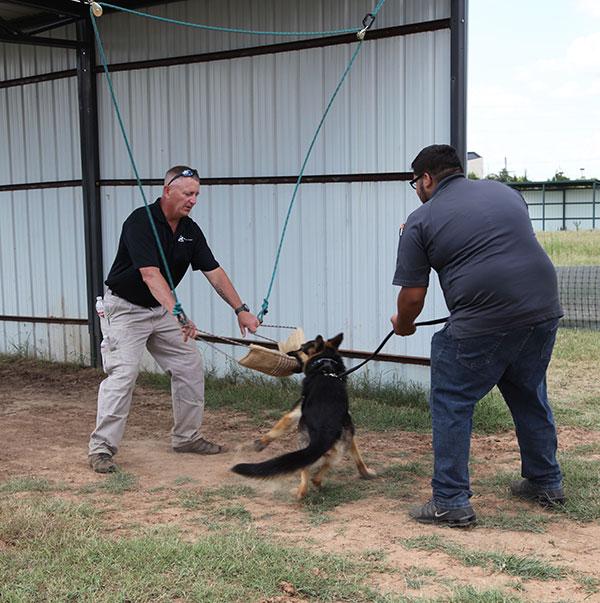
Veterinary Center Offers Canine Athletic Program
Friday, August 11, 2017
The number one killer of all law enforcement K9s throughout the United States in 2016 was not trauma. The dogs’ deaths were directly related to the lack of adequate conditioning and resistance to heat stress. Coordinated by Dr. Michael Davis, Oklahoma State University’s Center for Veterinary Health Sciences recently hosted an Advanced Canine Athletic Program to provide the latest knowledge and training techniques for improving working dog fitness.
“We’ve been doing research that supports this training for about two decades,” said Davis, director of the Center’s Comparative Exercise Physiology Laboratory and a professor in the Department of Physiological Sciences. “The information has been disseminated to the people who have paid for the research, mainly the military special operations. However, it’s every bit as beneficial to law enforcement dogs but they didn’t have access to the information unless we put together a workshop like this.”
The Advanced Canine Athletic Program was developed to increase the fitness of military dogs so that the military dogs would perform better and be a more valuable asset to deployed teams.
“Since development, that program has transitioned to more of a law enforcement orientation as the folks who developed it got out of the military and started a business, Guardian Point, to market this training program and develop better tools for law enforcement to mimic the capabilities that exist for the military,” continued Davis.
A total of 14 people attended the training representing municipal, state and federal law enforcement agencies as well as personal protection canine trainers and owners, some of whom are veterinarians.
“It’s great seeing the different agencies that have an interest in this,” explained Dr. Sean McPeck, an emergency veterinarian from Alaska who assisted with the three-day training program. “We can make these law enforcement and military working dogs much more effective.”
“I think the take away for attendees is the importance of training,” added Davis. “Just because the dog is a better athlete than the human right off the shelf, doesn’t mean that they won’t benefit from physical fitness and conditioning training just like a human does. In particular, the physical fitness will improve their resistance to heat injury. It will allow them to exercise harder under more stressful conditions without overheating. It also tends to decrease the number of injuries so it can potentially prolong the service life of the dog before they are forced to retire.”
“I have a profound interest in taking the athlete to the next level. And these working dogs are athletes and the conditioning is not there,” said McPeck. “A little bit of time, a little bit of investment daily and it will pay off. If you have the patience and invest 20 or 30 minutes a day, two or three months from now, you’re going to be just blown away by the results that you can achieve with your canine. I think we’re just touching on the tip of what they can do.”
Instructors with extensive experience in preparing dogs for military and law enforcement activities covered program design, nutrition, thermoregulation, supplements, conditioning equipment, canine exercise physiology and more in the three-day program. Attendees either brought their own canines or used dogs provided by the veterinary center for the exercise portion of the program.
Subject matter experts presenting at the Advanced Canine Athletic Program were:
- Alan Siering with 23 years of military service, 17 with the U.S. Special Operations Command and 10 years of that working with K9s. He handled canines on five combat deployments to both Iraq and Afghanistan conducting more than 400 direct action missions against enemy combatants in hostile territory.
- Randel Roy with 25 years of combined law enforcement and military experience. With more than 15 years of K9 service, he spent eight years as a Senior K9 Trainer for the U.S. Army Special Operations Command. He has conducted numerous successful K9 detection operations with various agencies and organizations including the FBI, ATF, Iowa State Department of Corrections, local businesses, Fed-Ex, UPS and the US Postal Service.
- Sean McPeck, DVM, with 21 years of military service, 18 years with canines. He has served as a Sniper Team Leader and as a veterinarian with the U.S. Special Operations Command. He authored and implemented the first Comprehensive Canine Conditioning Program, which is still in use.
- Michael Davis, DVM, PhD, DACVIM, DACVSMR, has more than 25 years of experience as a licensed veterinarian. He is also a board certified specialist in veterinary internal medicine and veterinary sports medicine and rehabilitation. Davis is a research physiologist and clinical expert in exercise physiology at Oklahoma State University. He has receive more than $8 million in research funding to study the effects of exercise stress in animal models, particularly racing sled dogs and military working dogs.
Special thanks to the program’s sponsors Guardian Point, the Comparative Exercise Physiology Lab, and Oklahoma State University’s Center for Veterinary Health Sciences.
